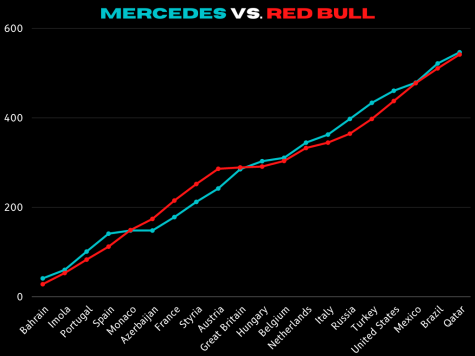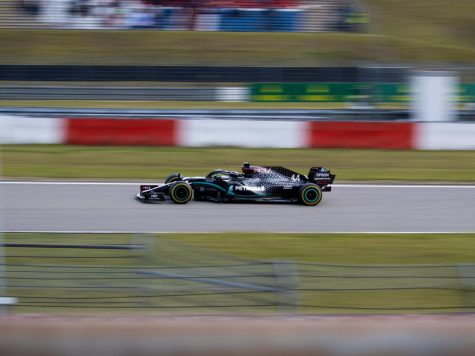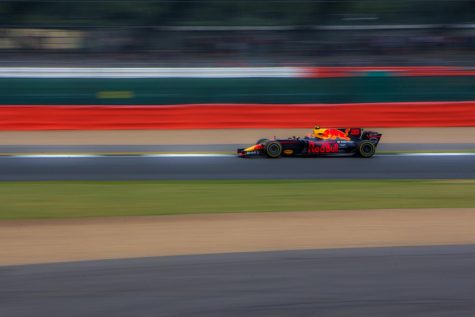The Exhilarating Battle for the Formula 1 Championship
December 5, 2021
Since 1958, Formula 1 has seen 15 different teams win the constructor’s championship, that is, the drivers in that team’s car have collectively scored more points than the drivers in any other team’s car.
Vanwall won the first championship, and Ferrari has won the most with fifteen. Since 2014, Mercedes has won a record seven consecutive constructor’s championships. One of their drivers has won the driver’s championship in all seven of those years, six of them being achieved by Englishman Lewis Hamilton. This year, both Hamilton and Mercedes have been facing fierce competition for the title(s) from the Red Bull Racing team led by Dutch driver Max Verstappen.

Red Bull Racing is not new to winning championships. From 2010 to 2013, they had their own streak of four championships. In 2014, new technical regulations came into effect, changing how the engine and aerodynamic structure of the cars could be built. Mercedes capitalized on these changes and brought themselves to the top. While Red Bull has never fallen past fourth in the constructor’s championship since the 2014 rule shift, they haven’t been anywhere near Mercedes.
The 2020 season proved to be another dominant season for Mercedes in which they won 13 of 17 races. But Red Bull made the jump for the 2021 season to challenge Mercedes.

This has also let Max Verstappen bring the fight to Lewis Hamilton for the driver’s championship. This close title fight has been quite evident on the track. Verstappen and Hamilton have had many close-calls, overtakes on each other, and even a few times where they touched cars. No matter which team or driver you support, it has been an undeniably thrilling competition. Here are some of the best moments from the season so far:
Bahrain – Spectators didn’t have to wait long to see an encounter between Verstappen and Hamilton. On lap 53 of 56, Verstappen overtook Hamilton for the lead going around the outside at Turn 4. But because Verstappen got past Hamilton while driving off the track, he was forced to give the position back to the Mercedes driver. Hamilton was able to hold the lead until the end of the race.
Imola – In the rain, Hamilton started first, but Verstappen quickly took the lead when he pushed Hamilton wide off the track on the first lap. Verstappen cruised to victory and Hamilton took second place, fighting his way from seventh after a spin midway through the race.
Azerbaijan – Verstappen looked poised to take a comfortable win, but on lap 46 of 51, his rear left tire failed, sending his car into the wall, taking him out of the running, and temporarily stopping the race. At the restart, Hamilton was in second, about to take first place, when he misjudged his braking point at turn 1, he fell to a 15th place finish.
Great Britain – Verstappen started from pole position with Hamilton right behind him. From the start of the race, Hamilton seemed almost desperate to gain the lead. Entering the high-speed corner called Copse on lap 1, Hamilton dove down the inside of Verstappen but was unable to make the overtake stick. Hamilton’s front left wheel and Verstappen’s rear right wheel collided, sending Verstappen off the track and out of the race. Hamilton was given a 10-second penalty for the incident but was able to squeeze out the victory in his home country.

Hungary – On the first lap of another wet race, Hamilton’s teammate, Valterri Bottas, crashed into the back of McLaren driver Lando Norris, sending him into Verstappen’s teammate Sergio Perez. Bottas himself continued skidding down the track and collided with Verstappen. Bottas and Perez were taken out of the race and Verstappen sustained damage to his car. Hamilton emerged from the crash in the lead, but after a strategy mistake during the race, he was only able to earn a second place finish. Verstappen finished ninth after struggling with his damaged car the entire race.
Italy – In a very similar incident to the one in Imola, Hamilton and Verstappen came side-by-side on the first lap. Hamilton was once again pushed wide by Verstappen and had to drive off the track to avoid a crash. This put Verstappen up into second place and Hamilton down to fourth. Hamilton saw his chance to overtake Verstappen when the Red Bull Driver took a pitstop that lasted 11.1 seconds (a typical F1 pitstop is 2-3 seconds). On lap 26, Hamilton took a pitstop of his own and when he reentered the track, he was next to Verstappen once again. Into the right-handed turn 1, Hamilton was marginally ahead. When they switched back to the left for turn 2, Verstappen quite literally drove on top of Hamilton’s car eliminating both of them from the race.
Brazil – After taking a penalty for installing a new engine into his car, Hamilton started 10th for the race in Sao Paulo. Verstappen started second but quickly took the lead from Hamilton’s teammate. Hamilton wove through the field as was in second place by lap 19 of 71. On lap 48, Hamilton sped past Verstappen one of the straights, then braking into turn 4, Verstappen took the inside line and pushed Hamilton off the track, along with himself, to maintain the lead. Eventually, on lap 59, Hamilton made the move stick and earned the race win.

Qatar – Formula 1’s most recent outing was much less eventful as Hamilton led the race from start to finish. But Verstappen managed to claw his way from seventh to second and minimize damage to his championship lead.
Going into the final two races, Verstappen leads Hamilton by just eight points and Mercedes tops Red Bull in the constructor’s standings by five. The next race will take place on December 5 in Saudi Arabia. It’s a track that F1 has never raced before, so it is unknown which team will have the advantage.
The season finale is one week later in Abu Dhabi where Red Bull could end its seven-year wait for a championship or Mercedes could extend its record to eight.



















